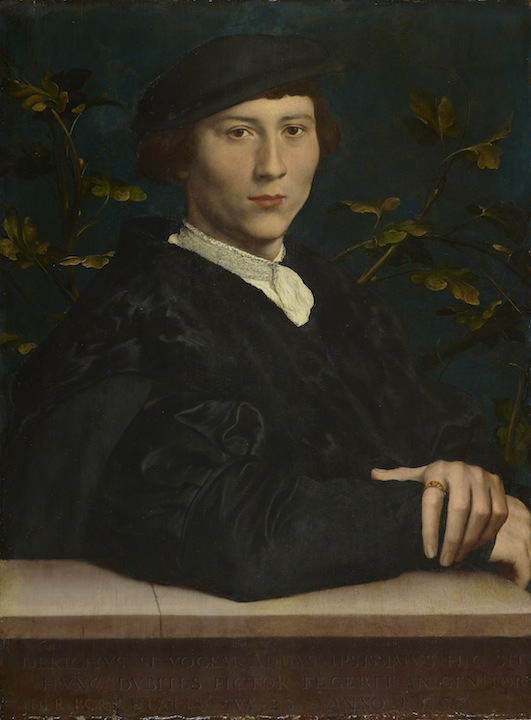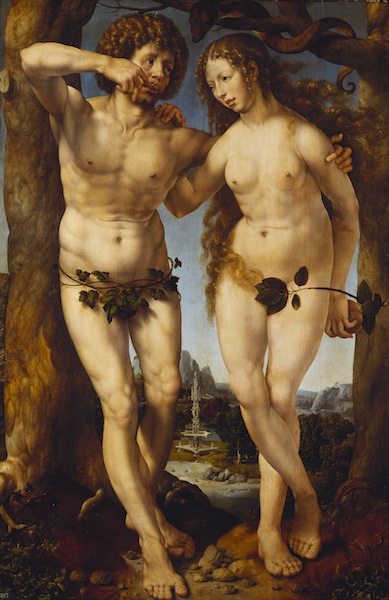The Northern Renaissance: Dürer to Holbein, The Queen's Gallery | reviews, news & interviews
The Northern Renaissance: Dürer to Holbein, The Queen's Gallery
The Northern Renaissance: Dürer to Holbein, The Queen's Gallery
A heady encounter with the material world of the Northern Renaissance

In what ways was the Northern Renaissance distinct from the Italian one? When we look at a painting by Holbein we’re struck by the painting’s rich surface: we admire the finely delineated weave of a Turkish rug, the individual hairs of fur lining a heavy coat, the intricate calligraphy of musical notation in an open hymn book. Since all is sumptuous surface and detail, our eyes feast upon the mass, weight and texture of objects firmly rooting us to the material world.
This isn’t to say that Italian Renaissance artists such as Leonardo, or Giovanni Bellini, aren’t enamoured by the finely wrought textures of the visible world. They are. But whereas our attention might be drawn to the way these artists are preoccupied by a subtle play of light, the expressive modelling of figures in light and shade, and in the delicate rendering of atmospheric effects, there is something so solidly physical and present in the work of the German artist that makes him an exemplar of Northern Renaissance art.
The Reformation produced a demand for images that glorified the secular
We think, too, of Holbein’s older German contemporary Albrecht Dürer, although both artists, in fact, learned a great deal from Italian art. Dürer twice visited Venice where Bellini was the presiding master, and his encounter with the aged artist drew his praise. “Though very old he is still the best in painting here," observed the ambitious young artist when he first visited the city from Nuremburg in the mid 1490s.
But one should make note of the far stronger Gothic influences informing the art north of the Alps. With an emphasis on linearity and a taste for filigree detailing, painting and printmaking of the Northern Renaissance carved out a distinct signature style, and this exhibition does a terrific job in drawing us into its world.
It’s a world in which portraits and mythological scenes have largely usurped religious ones, or else made religion appear a little more earthbound. In Germany it saw the arrival of the printing press 20 years before Dürer’s birth in 1471, enabling the artist to disseminate his engravings and intricate woodcuts and so spread his fame throughout Europe. And it’s a world in which the Reformation, in a decisive move away from idolatry, produced a demand for images that glorified the secular.
 Framing the exhibition are its two foremast German practitioners. From the Bavarian town of Augsburg, Hans Holbein the Younger became the King’s Painter in England in 1536, before which he’d made his reputation during long stints in both London and Basel. In 1527, eight years before Henry VIII ordered his execution for denying the supremacy of the crown, Holbein had painted his patron Thomas More, the social philosopher, humanist and Lord Chancellor to the King. Although we do not see this great portrait in this exhibition, which hangs in the Frick Collection, the Royal Collection does own a fine and detailed cartoon of the painting, which we see here. With his gaze a little softer and less focused, and his face a little rounder, the drawing presents him as less the politician, more the visionary (image above right: Holbein, Derich Born, 1534).
Framing the exhibition are its two foremast German practitioners. From the Bavarian town of Augsburg, Hans Holbein the Younger became the King’s Painter in England in 1536, before which he’d made his reputation during long stints in both London and Basel. In 1527, eight years before Henry VIII ordered his execution for denying the supremacy of the crown, Holbein had painted his patron Thomas More, the social philosopher, humanist and Lord Chancellor to the King. Although we do not see this great portrait in this exhibition, which hangs in the Frick Collection, the Royal Collection does own a fine and detailed cartoon of the painting, which we see here. With his gaze a little softer and less focused, and his face a little rounder, the drawing presents him as less the politician, more the visionary (image above right: Holbein, Derich Born, 1534).
A similar physical transformation is enacted with the portrait of Sir Henry Guildford. Holbein’s drawing, which we see alongside the painting, finds Sir Henry somewhat fuller-faced, while the finished portrait sees the nose and face lengthened, giving the courtier a sterner aspect. But one of the most arresting portraits in the exhibition is Holbein’s painting of Derich Born, a young Hanseatic merchant, whom Holbein painted in 1533. The inscription on the stone ledge on which the young man leans his arm aptly reads: “You would be in doubt whether the painter or his father made him.”
 We are spoilt for the number of prints by Dürer, including his famous woodcut of a rhinoceros (1515), a creature that he’d never seen in real life and here portrayed as if armour-plated and clad in chainmail. Then there is the daintily elegant study of a greyhound, drawn in about 1500, which was the same year Dürer painted his best-known self-portrait, the one in which he gazes out at us like Christ. Meanwhile, one of his most stunning engravings is St Jerome in his Study, 1524, impressive not only as a study in perspective, but for its softly variegated tones.
We are spoilt for the number of prints by Dürer, including his famous woodcut of a rhinoceros (1515), a creature that he’d never seen in real life and here portrayed as if armour-plated and clad in chainmail. Then there is the daintily elegant study of a greyhound, drawn in about 1500, which was the same year Dürer painted his best-known self-portrait, the one in which he gazes out at us like Christ. Meanwhile, one of his most stunning engravings is St Jerome in his Study, 1524, impressive not only as a study in perspective, but for its softly variegated tones.
From here we encounter Lucas Cranach the Elder’s The Judgement of Paris, 1530-35, and from the Netherlands Jan Gossaert’s embracing Adam and Eve, c1520 (image left), and Hans Memling’s beguilingly sombre Portrait of a Young Man, c1475-80. And then, wonderfully, Pieter Bruegel The Elder’s Massacre of the Innocents, 1565-67 (main image), a wintry, panoramic scene that ostensibly depicts the slaying of the young under the orders of King Herod. However, as we see in the nearby infra-red image, the slaughtered infants were painted over by a later artist with details such as bundles, food and animals. If you look hard, you can just about catch shadowy glimpses beneath the over-painted surface.
This is an exhibition that ranges across Germany, the Netherlands, France and the Holy Roman Empire. The unsettling sight of a ghost of a Bruegal infant notwithstanding, it is full of senusal delights.
- The Northern Renaissance: Dürer to Holbein until 14 April 2013
Explore topics
Share this article
Add comment
The future of Arts Journalism
You can stop theartsdesk.com closing!
We urgently need financing to survive. Our fundraising drive has thus far raised £49,000 but we need to reach £100,000 or we will be forced to close. Please contribute here: https://gofund.me/c3f6033d
And if you can forward this information to anyone who might assist, we’d be grateful.

Subscribe to theartsdesk.com
Thank you for continuing to read our work on theartsdesk.com. For unlimited access to every article in its entirety, including our archive of more than 15,000 pieces, we're asking for £5 per month or £40 per year. We feel it's a very good deal, and hope you do too.
To take a subscription now simply click here.
And if you're looking for that extra gift for a friend or family member, why not treat them to a theartsdesk.com gift subscription?
more Visual arts
 'We are bowled over!' Thank you for your messages of love and support
Much-appreciated words of commendation from readers and the cultural community
'We are bowled over!' Thank you for your messages of love and support
Much-appreciated words of commendation from readers and the cultural community
 Folkestone Triennial 2025 - landscape, seascape, art lovers' escape
Locally rooted festival brings home many but not all global concerns
Folkestone Triennial 2025 - landscape, seascape, art lovers' escape
Locally rooted festival brings home many but not all global concerns
 Sir Brian Clarke (1953-2025) - a personal tribute
Remembering an artist with a gift for the transcendent
Sir Brian Clarke (1953-2025) - a personal tribute
Remembering an artist with a gift for the transcendent
 Emily Kam Kngwarray, Tate Modern review - glimpses of another world
Pictures that are an affirmation of belonging
Emily Kam Kngwarray, Tate Modern review - glimpses of another world
Pictures that are an affirmation of belonging
 Kiefer / Van Gogh, Royal Academy review - a pairing of opposites
Small scale intensity meets large scale melodrama
Kiefer / Van Gogh, Royal Academy review - a pairing of opposites
Small scale intensity meets large scale melodrama
 Jenny Saville: The Anatomy of Painting, National Portrait Gallery review - a protégé losing her way
A brilliant painter in search of a worthwhile subject
Jenny Saville: The Anatomy of Painting, National Portrait Gallery review - a protégé losing her way
A brilliant painter in search of a worthwhile subject
 Abstract Erotic, Courtauld Gallery review - sculpture that is sensuous, funny and subversive
Testing the boundaries of good taste, and winning
Abstract Erotic, Courtauld Gallery review - sculpture that is sensuous, funny and subversive
Testing the boundaries of good taste, and winning
 Edward Burra, Tate Britain review - watercolour made mainstream
Social satire with a nasty bite
Edward Burra, Tate Britain review - watercolour made mainstream
Social satire with a nasty bite
 Ithell Colquhoun, Tate Britain review - revelations of a weird and wonderful world
Emanations from the unconscious
Ithell Colquhoun, Tate Britain review - revelations of a weird and wonderful world
Emanations from the unconscious
 Rachel Jones: Gated Canyons, Dulwich Picture Gallery review - teeth with a real bite
Mouths have never looked so good
Rachel Jones: Gated Canyons, Dulwich Picture Gallery review - teeth with a real bite
Mouths have never looked so good
 Yoshitomo Nara, Hayward Gallery review - sickeningly cute kids
How to make millions out of kitsch
Yoshitomo Nara, Hayward Gallery review - sickeningly cute kids
How to make millions out of kitsch
 Hamad Butt: Apprehensions, Whitechapel Gallery review - cool, calm and potentially lethal
The YBA who didn’t have time to become a household name
Hamad Butt: Apprehensions, Whitechapel Gallery review - cool, calm and potentially lethal
The YBA who didn’t have time to become a household name

Comments
A really marvelous
A really marvelous exhibition, beautifully curated & hung. So many treasures here that are not mentioned in the review. And the (2) catalogues are excellent too, with exquisite layout & colour repro.